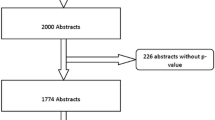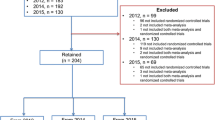Abstract
Since its introduction in the twentieth century, null hypothesis significance testing (NHST), a hybrid of significance testing (ST) advocated by Fisher and null hypothesis testing (NHT) developed by Neyman and Pearson, has become widely adopted but has also been a source of debate. The principal alternative to such testing is estimation with point estimates and confidence intervals (CI). Our aim was to estimate time trends in NHST, ST, NHT and CI reporting in abstracts of major medical and epidemiological journals. We reviewed 89,533 abstracts in five major medical journals and seven major epidemiological journals, 1975–2014, and estimated time trends in the proportions of abstracts containing statistical inference. In those abstracts, we estimated time trends in the proportions relying on NHST and its major variants, ST and NHT, and in the proportions reporting CIs without explicit use of NHST (CI-only approach). The CI-only approach rose monotonically during the study period in the abstracts of all journals. In Epidemiology abstracts, as a result of the journal’s editorial policy, the CI-only approach has always been the most common approach. In the other 11 journals, the NHST approach started out more common, but by 2014, this disparity had narrowed, disappeared or reversed in 9 of them. The exceptions were JAMA, New England Journal of Medicine, and Lancet abstracts, where the predominance of the NHST approach prevailed over time. In 2014, the CI-only approach is as popular as the NHST approach in the abstracts of 4 of the epidemiology journals: the American Journal of Epidemiology (48%), the Annals of Epidemiology (55%), Epidemiology (79%) and the International Journal of Epidemiology (52%). The reporting of CIs without explicitly interpreting them as statistical tests is becoming more common in abstracts, particularly in epidemiology journals. Although NHST is becoming less popular in abstracts of most epidemiology journals studied and some widely read medical journals, it is still very common in the abstracts of other widely read medical journals, especially in the hybrid form of ST and NHT in which p values are reported numerically along with declarations of the presence or absence of statistical significance.



Similar content being viewed by others
References
Gigerenzer G, Swijtink Z, Porter T, Daston L, Beatty J, Krüger L. The empire of chance. How probability changed science and everyday life. Cambridge: Cambridge University Press; 1989.
Anderson DR, Burnham KP, Thompson WL. Null hypothesis testing: problems, prevalence, and an alternative. J Wildl Manag. 2000;64(4):912–23.
Rothman KJ. A show of confidence. N Engl J Med. 1978;299(24):1362–3.
International Committee of Medical Journal Editors. Uniform requirements for manuscripts submitted to biomedical journals. Br Med J (Clin Res Ed). 1988;296(6619):401–5.
Gardner MJ, Altman DG. Confidence intervals rather than P values: estimation rather than hypothesis testing. Br Med J (Clin Res Ed). 1986;292(6522):746–50.
Rothman KJ. Significance questing. Ann Intern Med. 1986;105(3):445–7.
Weinberg CR. It’s time to rehabilitate the P-value. Epidemiology. 2001;12(3):288–90.
Sterne JA, Davey SG. Sifting the evidence-what’s wrong with significance tests? BMJ. 2001;322(7280):226–31.
Greenland S, Senn SJ, Rothman KJ, et al. Statistical tests, P values, confidence intervals, and power: a guide to misinterpretations. Eur J Epidemiol. 2016;31(4):337–50.
Wasserstein RL, Lazar NA. The ASA’s statement on p-values: context, process, and purpose. Am Stat. 2016;70(2):129–33.
Walter SD. Methods of reporting statistical results from medical research studies. Am J Epidemiol. 1995;141(10):896–906.
Gastwirth JL. Statistical considerations support the supreme court’s decision in Matrixx Initiatives v. Siracusano. Jurimetrics. 2012;52:155–75.
Trafimow D, Marks M. Editorial. Basic Appl Soc Psych. 2015;37:1–2.
Anonymous. Psychology journal bans P values. Nature 2015; 519:9.
Savitz DA, Tolo KA, Poole C. Statistical significance testing in the American Journal of Epidemiology, 1970–1990. Am J Epidemiol. 1994;139(10):1047–52.
Fidler F, Thomason N, Cumming G, Finch S, Leeman J. Editors can lead researchers to confidence intervals, but can’t make them think: statistical reform lessons from medicine. Psychol Sci. 2004;15(2):119–26.
MacArthur RD, Jackson GG. An evaluation of the use of statistical methodology in the. J Infect Dis. 1984;149(3):349–54.
Vacha-Haase T, Nilsson JE, Reetz DR, Lance TS, Thompson B. Reporting practices and APA editorial policies regarding statistical significance and effect size. Theory Psychol. 2000;10(3):413–25.
Chavalarias D, Wallach JD, Li AH, Ioannidis JP. Evolution of reporting P values in the biomedical literature, 1990–2015. JAMA. 2016;315(11):1141–8.
Fritz A, Scherndl T, Kühlberger A. A comprehensive review of reporting practices in psychological journals: are effect sizes really enough? Theory Psychol. 2012;23(1):98–112.
Thompson B. Journal editorial policies regarding statistical significance tests: heat is to fire as p is to importance. Educ Psychol Rev. 1999;11(2):157–69.
Cleveland WS, Devlin S, Grosse E. Regression by local fitting. J Econom. 1988;37:87–114.
Cleveland WS, Grosse E. Computational methods for local regression. Stat Comput. 1991;1:47–62.
Newcombe RG. Two-sided confidence intervals for the single proportion: comparison of seven methods. Stat Med. 1998;17(8):857–72.
Milne PH. Presentation graphics for engineering, science, and business. London: E & FN Spon; 2005.
Horton NJ, Switzer SS. Statistical methods in the journal. N Engl J Med. 2005;353(18):1977–9.
Felson DT, Cupples LA, Meenan RF. Misuse of statistical methods in Arthritis and Rheumatism. 1982 versus 1967-68. Arthritis Rheum. 1984;27(9):1018–22.
Arnold LD, Braganza M, Salih R, Colditz GA. Statistical trends in the Journal of the American Medical Association and implications for training across the continuum of medical education. PLoS ONE. 2013;8(10):e77301.
Jin Z, Yu D, Zhang L, et al. A retrospective survey of research design and statistical analyses in selected Chinese medical journals in 1998 and 2008. PLoS ONE. 2010;5(5):e10822.
Guidance for Industry. E9 Statistical Principles for Clinical Trials. Food and Drug Administration 1998. www.fda.gov/downloads/drugs/guidancecomplianceregulatoryinformation/guidances/ucm073137.pdf. Accessed Oct 4, 2015.
Deeks JJ, Higgins JPT, Altman DG. Analysing data and undertaking meta-analyses. In: Higgins JPT, Green S, editors. Cochrane handbook for systematic reviews of interventions version 510 (updated March 2011): Cochrane Collaboration (www.handbook.cochrane.com); 2011.
Koricheva J, Gurevitch J. Place of meta-analysis among other methods of research synthesis. In: Koricheva J, Gurevitch J, Mengerson K, editors. Handbook of meta-analysis in ecology and evolution. Princeton: Princeton University Press; 2013. p. 1–13.
Freemantle N, Geddes J. Understanding and interpreting systematic reviews and meta-analyses. Part 2: meta-analyses. Evid Based. Mental Health. 1998;1:102–4.
Borenstein M, Hedges LV, Higgins JPT, Rothstein HR. Introduction to meta-analysis. Chichester: Wiley; 2009. P. 251–5, 297–302, 325–31.
Acknowledgements
The authors thank Sander Greenland, DrPH for valuable comments on an early draft.
Funding
Andreas Stang receives a grant from the German Federal Ministry of Education and Science (BMBF), Grant Number 01ER1305.
Author information
Authors and Affiliations
Corresponding author
Ethics declarations
Conflict of interest
None of the authors declares a conflict of interest.
Authors’ contributions
AS, MD, CP, and KJR were involved in the study design. AS and MD performed the statistical analyses. AS wrote the first draft of the report. All authors contributed to the final version.
Electronic supplementary material
Below is the link to the electronic supplementary material.
Rights and permissions
About this article
Cite this article
Stang, A., Deckert, M., Poole, C. et al. Statistical inference in abstracts of major medical and epidemiology journals 1975–2014: a systematic review. Eur J Epidemiol 32, 21–29 (2017). https://doi.org/10.1007/s10654-016-0211-1
Received:
Accepted:
Published:
Issue Date:
DOI: https://doi.org/10.1007/s10654-016-0211-1




